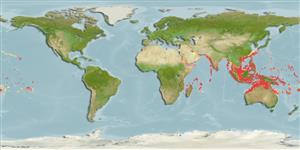Environment: milieu / climate zone / depth range / distribution range
Écologie
marin récifal; profondeur 6 - 300 m (Ref. 1602). Tropical; 30°N - 23°S, 36°E - 140°W
Indo-Pacific: East Africa to Southeast Asia and the Marquesan and Society islands, north to southern Japan, south to New Caledonia.
Taille / Poids / Âge
Maturity: Lm ? range ? - ? cm
Max length : 92.3 cm FL mâle / non sexé; (Ref. 125599); common length : 50.0 cm TL mâle / non sexé; (Ref. 9768); poids max. publié: 4.1 kg (Ref. 125599)
Épines dorsales (Total) : 6; Rayons mous dorsaux (Total) : 9; Épines anales: 2; Rayons mous anaux: 9. Body elongate and sub cylindrical with small cycloid scales; head long and pointed. Mouth large and horizontal, the tip of the lower jaw protruding; intermaxilla non-protractile. Preoperculum broadly rounded. Lower limb of the first fill arch with spiny tubercles. First dorsal fin origin opposite or before the pectoral tip, the first spine shorter than the second. Color is generally blackish above and silvery below.
Nocturnally active, but occurring in large schools above lagoon patch reefs and along outer reef slopes during the day (Ref. 9768, 48637). Feeds mainly on fishes, but also on penaeid shrimps and squids. Sold fresh, frozen or dried salted. Reports of ciguatera poisoning need confirmation.
Life cycle and mating behavior
Maturities | Reproduction | Spawnings | Egg(s) | Fecundities | Larves
Rose, J.H., 1984. Sphyraenidae. In W. Fischer and G. Bianchi (eds.) FAO species identification sheets for fishery purposes. Western Indian Ocean (Fishing Area 51). Vol. 4. FAO, Rome. pag. var. (Ref. 4752)
Statut dans la liste rouge de l'IUCN (Ref. 130435)
Menace pour l'homme
Reports of ciguatera poisoning (Ref. 30298)
Utilisations par l'homme
Pêcheries: commercial
Outils
Articles particuliers
Télécharger en XML
Sources Internet
Estimates based on models
Preferred temperature (Ref.
123201): 19.4 - 28.2, mean 26.2 °C (based on 976 cells).
Phylogenetic diversity index (Ref.
82804): PD
50 = 0.5000 [Uniqueness, from 0.5 = low to 2.0 = high].
Bayesian length-weight: a=0.00724 (0.00479 - 0.01095), b=2.92 (2.80 - 3.04), in cm total length, based on LWR estimates for this species & Genus-body shape (Ref.
93245).
Niveau trophique (Ref.
69278): 4.4 ±0.0 se; based on diet studies.
Résilience (Ref.
120179): Faible, temps minimum de doublement de population : 4,5 à 14 années (Preliminary K or Fecundity.).
Fishing Vulnerability (Ref.
59153): High vulnerability (61 of 100).
Nutrients (Ref.
124155): Calcium = 16 [7, 42] mg/100g; Iron = 0.289 [0.130, 0.614] mg/100g; Protein = 20.1 [18.1, 21.7] %; Omega3 = 0.103 [0.048, 0.214] g/100g; Selenium = 46.3 [20.1, 115.3] μg/100g; VitaminA = 46.7 [10.3, 220.9] μg/100g; Zinc = 0.448 [0.286, 0.779] mg/100g (wet weight);
